12.32: Fish Classification
- Page ID
- 13236
\( \newcommand{\vecs}[1]{\overset { \scriptstyle \rightharpoonup} {\mathbf{#1}} } \)
\( \newcommand{\vecd}[1]{\overset{-\!-\!\rightharpoonup}{\vphantom{a}\smash {#1}}} \)
\( \newcommand{\dsum}{\displaystyle\sum\limits} \)
\( \newcommand{\dint}{\displaystyle\int\limits} \)
\( \newcommand{\dlim}{\displaystyle\lim\limits} \)
\( \newcommand{\id}{\mathrm{id}}\) \( \newcommand{\Span}{\mathrm{span}}\)
( \newcommand{\kernel}{\mathrm{null}\,}\) \( \newcommand{\range}{\mathrm{range}\,}\)
\( \newcommand{\RealPart}{\mathrm{Re}}\) \( \newcommand{\ImaginaryPart}{\mathrm{Im}}\)
\( \newcommand{\Argument}{\mathrm{Arg}}\) \( \newcommand{\norm}[1]{\| #1 \|}\)
\( \newcommand{\inner}[2]{\langle #1, #2 \rangle}\)
\( \newcommand{\Span}{\mathrm{span}}\)
\( \newcommand{\id}{\mathrm{id}}\)
\( \newcommand{\Span}{\mathrm{span}}\)
\( \newcommand{\kernel}{\mathrm{null}\,}\)
\( \newcommand{\range}{\mathrm{range}\,}\)
\( \newcommand{\RealPart}{\mathrm{Re}}\)
\( \newcommand{\ImaginaryPart}{\mathrm{Im}}\)
\( \newcommand{\Argument}{\mathrm{Arg}}\)
\( \newcommand{\norm}[1]{\| #1 \|}\)
\( \newcommand{\inner}[2]{\langle #1, #2 \rangle}\)
\( \newcommand{\Span}{\mathrm{span}}\) \( \newcommand{\AA}{\unicode[.8,0]{x212B}}\)
\( \newcommand{\vectorA}[1]{\vec{#1}} % arrow\)
\( \newcommand{\vectorAt}[1]{\vec{\text{#1}}} % arrow\)
\( \newcommand{\vectorB}[1]{\overset { \scriptstyle \rightharpoonup} {\mathbf{#1}} } \)
\( \newcommand{\vectorC}[1]{\textbf{#1}} \)
\( \newcommand{\vectorD}[1]{\overrightarrow{#1}} \)
\( \newcommand{\vectorDt}[1]{\overrightarrow{\text{#1}}} \)
\( \newcommand{\vectE}[1]{\overset{-\!-\!\rightharpoonup}{\vphantom{a}\smash{\mathbf {#1}}}} \)
\( \newcommand{\vecs}[1]{\overset { \scriptstyle \rightharpoonup} {\mathbf{#1}} } \)
\( \newcommand{\vecd}[1]{\overset{-\!-\!\rightharpoonup}{\vphantom{a}\smash {#1}}} \)
\(\newcommand{\avec}{\mathbf a}\) \(\newcommand{\bvec}{\mathbf b}\) \(\newcommand{\cvec}{\mathbf c}\) \(\newcommand{\dvec}{\mathbf d}\) \(\newcommand{\dtil}{\widetilde{\mathbf d}}\) \(\newcommand{\evec}{\mathbf e}\) \(\newcommand{\fvec}{\mathbf f}\) \(\newcommand{\nvec}{\mathbf n}\) \(\newcommand{\pvec}{\mathbf p}\) \(\newcommand{\qvec}{\mathbf q}\) \(\newcommand{\svec}{\mathbf s}\) \(\newcommand{\tvec}{\mathbf t}\) \(\newcommand{\uvec}{\mathbf u}\) \(\newcommand{\vvec}{\mathbf v}\) \(\newcommand{\wvec}{\mathbf w}\) \(\newcommand{\xvec}{\mathbf x}\) \(\newcommand{\yvec}{\mathbf y}\) \(\newcommand{\zvec}{\mathbf z}\) \(\newcommand{\rvec}{\mathbf r}\) \(\newcommand{\mvec}{\mathbf m}\) \(\newcommand{\zerovec}{\mathbf 0}\) \(\newcommand{\onevec}{\mathbf 1}\) \(\newcommand{\real}{\mathbb R}\) \(\newcommand{\twovec}[2]{\left[\begin{array}{r}#1 \\ #2 \end{array}\right]}\) \(\newcommand{\ctwovec}[2]{\left[\begin{array}{c}#1 \\ #2 \end{array}\right]}\) \(\newcommand{\threevec}[3]{\left[\begin{array}{r}#1 \\ #2 \\ #3 \end{array}\right]}\) \(\newcommand{\cthreevec}[3]{\left[\begin{array}{c}#1 \\ #2 \\ #3 \end{array}\right]}\) \(\newcommand{\fourvec}[4]{\left[\begin{array}{r}#1 \\ #2 \\ #3 \\ #4 \end{array}\right]}\) \(\newcommand{\cfourvec}[4]{\left[\begin{array}{c}#1 \\ #2 \\ #3 \\ #4 \end{array}\right]}\) \(\newcommand{\fivevec}[5]{\left[\begin{array}{r}#1 \\ #2 \\ #3 \\ #4 \\ #5 \\ \end{array}\right]}\) \(\newcommand{\cfivevec}[5]{\left[\begin{array}{c}#1 \\ #2 \\ #3 \\ #4 \\ #5 \\ \end{array}\right]}\) \(\newcommand{\mattwo}[4]{\left[\begin{array}{rr}#1 \amp #2 \\ #3 \amp #4 \\ \end{array}\right]}\) \(\newcommand{\laspan}[1]{\text{Span}\{#1\}}\) \(\newcommand{\bcal}{\cal B}\) \(\newcommand{\ccal}{\cal C}\) \(\newcommand{\scal}{\cal S}\) \(\newcommand{\wcal}{\cal W}\) \(\newcommand{\ecal}{\cal E}\) \(\newcommand{\coords}[2]{\left\{#1\right\}_{#2}}\) \(\newcommand{\gray}[1]{\color{gray}{#1}}\) \(\newcommand{\lgray}[1]{\color{lightgray}{#1}}\) \(\newcommand{\rank}{\operatorname{rank}}\) \(\newcommand{\row}{\text{Row}}\) \(\newcommand{\col}{\text{Col}}\) \(\renewcommand{\row}{\text{Row}}\) \(\newcommand{\nul}{\text{Nul}}\) \(\newcommand{\var}{\text{Var}}\) \(\newcommand{\corr}{\text{corr}}\) \(\newcommand{\len}[1]{\left|#1\right|}\) \(\newcommand{\bbar}{\overline{\bvec}}\) \(\newcommand{\bhat}{\widehat{\bvec}}\) \(\newcommand{\bperp}{\bvec^\perp}\) \(\newcommand{\xhat}{\widehat{\xvec}}\) \(\newcommand{\vhat}{\widehat{\vvec}}\) \(\newcommand{\uhat}{\widehat{\uvec}}\) \(\newcommand{\what}{\widehat{\wvec}}\) \(\newcommand{\Sighat}{\widehat{\Sigma}}\) \(\newcommand{\lt}{<}\) \(\newcommand{\gt}{>}\) \(\newcommand{\amp}{&}\) \(\definecolor{fillinmathshade}{gray}{0.9}\)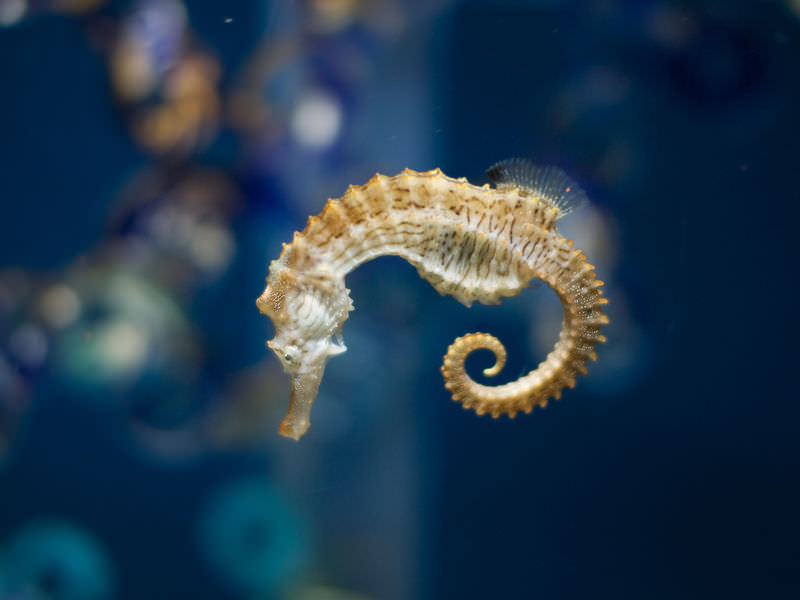
What type of animal is a sea horse? Is it actually a fish?
It is, and there are about 50 species of seahorses. Although they are bony fish, they do not have scales, but rather a thin skin stretched over a series of bony plates arranged in rings throughout their body. Each species has a distinct number of rings. Seahorses have a coronet on their head, which is distinct to each individual, much like a human fingerprint. Seahorses also swim upright, a characteristic not shared by other fish. Seahorses are poor swimmers, so they are most likely to be found resting, with their prehensile tails wound around a stationary object. They have long snouts, which they use to suck up food, and eyes that can move independently of each other. Seahorses eat small shrimp, tiny fish, crustaceans, and plankton.
Classification of Fish
There are about 28,000 existing species of fish, and they are placed in five different classes. The classes are commonly referred to as hagfish, lampreys, cartilaginous fish, ray-finned fish, and lobe-finned fish (see the table in the previous lesson).
Hagfish
Hagfish are very primitive fish. They retain their notochord throughout life rather than developing a backbone, and they lack scales and fins. They are classified as vertebrates mainly because they have a cranium. Hagfish are noted for secreting large amounts of thick, slimy mucus. The mucus makes them slippery, so they can slip out of the jaws of predators.
Lampreys
Like hagfish, lampreys also lack scales, but they have fins and a partial backbone. The most striking feature of lampreys is a large round sucker, lined with teeth, that surrounds the mouth (see Figure below). Lampreys use their sucker to feed on the blood of other fish species.
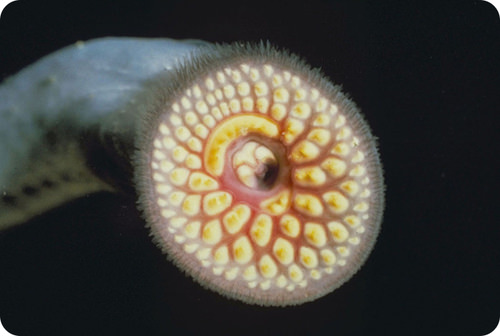 Sucker Mouth of a Lamprey. The mouth of a lamprey is surrounded by a tooth-lined sucker.
Sucker Mouth of a Lamprey. The mouth of a lamprey is surrounded by a tooth-lined sucker.Cartilaginous Fish
Cartilaginous fish include sharks, rays, and ratfish (see Figure below). In addition to an endoskeleton composed of cartilage, these fish have a complete backbone. They also have a relatively large brain. They can solve problems and interact with other members of their species. They are generally predators with keen senses. Cartilaginous fish lack a swim bladder. Instead, they stay afloat by using a pair of muscular fins to push down against the water and create lift.
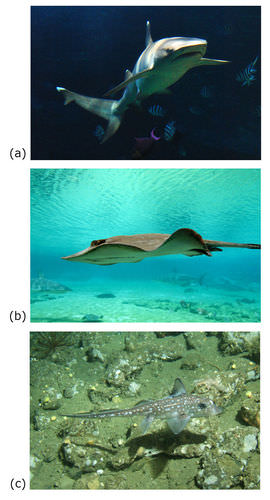 Cartilaginous Fish. All of these fish belong to the class of cartilaginous fish with jaws. (a) Oceanic whitetip shark (b) Ray (c) Ratfish
Cartilaginous Fish. All of these fish belong to the class of cartilaginous fish with jaws. (a) Oceanic whitetip shark (b) Ray (c) RatfishOne of the most important traits of cartilaginous fish is their jaws. Jaws allow them to bite food and break it into smaller pieces. This is a big adaptive advantage because it greatly expands the range of food sources they can consume. Jaws also make cartilaginous fish excellent predators. It you’ve ever seen the film Jaws, then you know that jaws make sharks very fierce predators (see also Figure below).
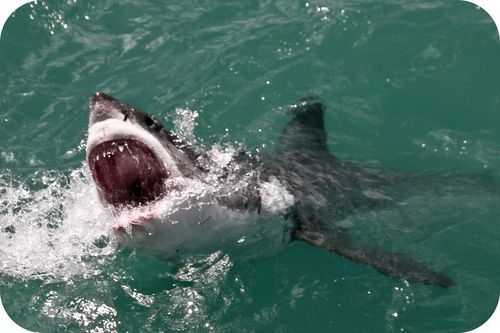 Jaws of a Shark. Sharks have powerful jaws with multiple rows of sharp, saw-like teeth. Most other fish are no match for these powerful predators.
Jaws of a Shark. Sharks have powerful jaws with multiple rows of sharp, saw-like teeth. Most other fish are no match for these powerful predators.Ray-Finned Fish
Ray-finned fish include the majority of living fish species, including goldfish, tuna, salmon, perch, and cod. They have a bony endoskeleton and a swim bladder. Their thin fins consist of webs of skin over flexible bony rays, or spines. The fins lack muscle, so their movements are controlled by muscles in the body wall. You can compare their ray fins with the fleshy fins of lobe-finned fish in Figure below.
 Fins of Bony Fish. The fins of ray-finned and lobe-finned fish are quite different. How is the form of the fins related to their different functions in the two classes of fish? Ray Fin (left), Lobe Fin (right)
Fins of Bony Fish. The fins of ray-finned and lobe-finned fish are quite different. How is the form of the fins related to their different functions in the two classes of fish? Ray Fin (left), Lobe Fin (right)Lobe-Finned Fish
Lobe-finned fish are currently far fewer in number than ray-finned fish. Their fins, like the one shown in Figure above, contain a stump-like appendage of bone and muscle. There are two groups of lobe-finned fish still alive today: coelacanths and lungfish.
- Coelacanths are ancient fish with just two living species. They are at risk of extinction because of their very small numbers.
- Lungfish have a lung-like organ for breathing air. The organ is an adaptation of the swim bladder. It allows them to survive for long periods out of water.
Science Friday: Oarfish: The Ultimate Fish Tale
Thought to the be inspiration of "sea serpent" stories, the monstrously-long Oarfish provokes wonder in nearly all that witness it. In this video by Science Friday, Professor Misty Paig-Tran provides us with insights into this real-life "sea monster's" unusual physiology.
Summary
- There are about 28,000 existing species of fish, and they are placed in five classes: hagfish, lampreys, cartilaginous fish, ray-finned bony fish, and lobe-finned bony fish.
Review
- Assume that a new species of fish has been discovered deep in the ocean. It has a complete vertebral column made of cartilage. Which class should the new species be placed in? Name one other trait you would expect to find in the new species of fish. Explain your answers.
- Fish with jaws may be very large. Infer how their jaws may be related to their large body size.
- The majority of living fish belong to what class?
- Describe the lungfish.
| Image | Reference | Attributions |
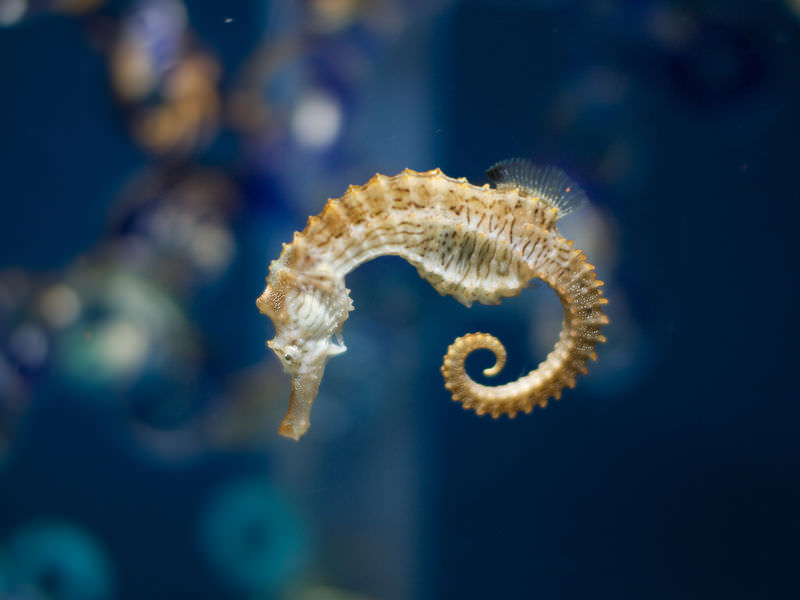 |
[Figure 1] | License: CC BY-NC |
 |
[Figure 2] | Credit: Courtesy of the US Fish and Wildlife Service;By Nobu Tamura email:nobu.tamura@yahoo.com http://spinops.blogspot.com/ - Own work, CC BY-SA 4.0, commons.wikimedia.org/w/inde...curid=50429141 Source: www.flickr.com/photos/usfwspacific/7129906737/ ; By Nobu Tamura email:nobu.tamura@yahoo.com - Own workhttp://spinops.blogspot.com/ ; CC BY-SA 4.0 ; commons.wikimedia.org/w/index.php?curid=50429141 License: CC BY 2.0 |
 |
[Figure 3] | Credit: (a) Image copyright Dray van Beeck, 2014; (b) Barry Peters (petersbar); (c) Linda Snook/MBNMS/US National Oceanic and Atmospheric Administration;By Nobu Tamura email:nobu.tamura@yahoo.com http://spinops.blogspot.com/ - Own work, CC BY-SA 4.0, commons.wikimedia.org/w/inde...curid=50429141 Source: (a) http://www.shutterstock.com ; (b) commons.wikimedia.org/wiki/File:Southern_stingrays_at_stingray_city.jpg ; (c) commons.wikimedia.org/wiki/File:Hydrolagus_colliei.jpg ; By Nobu Tamura email:nobu.tamura@yahoo.com - Own workhttp://spinops.blogspot.com/ ; CC BY-SA 4.0 ; commons.wikimedia.org/w/index.php?curid=50429141 License: (A) License from Shutterstock; (B) CC BY 2.0; (C) Public Domain |
 |
[Figure 4] | Credit: Grant Peters Source: http://www.flickr.com/photos/grantpetersphotography/7033043857/ License: CC BY 2.0 |
 |
[Figure 5] | Credit: (left) Image copyright Zheltyshev, 2014; (right) David Jolivet;By Nobu Tamura email:nobu.tamura@yahoo.com http://spinops.blogspot.com/ - Own work, CC BY-SA 4.0, https://commons.wikimedia.org/w/inde...curid=50429141 Source: (left) http://www.shutterstock.com ; (right) http://www.flickr.com/photos/sybarite48/5246927772/ ; By Nobu Tamura email:nobu.tamura@yahoo.com - Own workhttp://spinops.blogspot.com/ ; CC BY-SA 4.0 ; commons.wikimedia.org/w/index.php?curid=50429141 License: Left: License from Shutterstock; Right: CC BY 2.0 |

